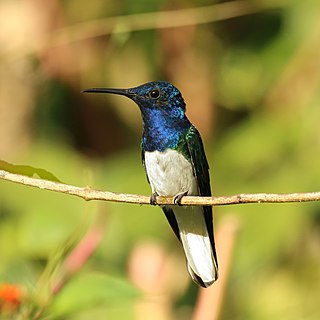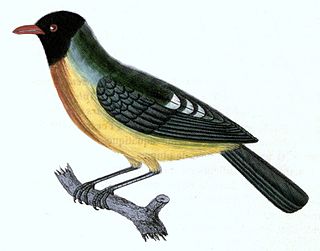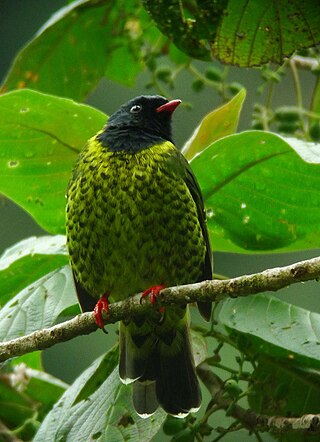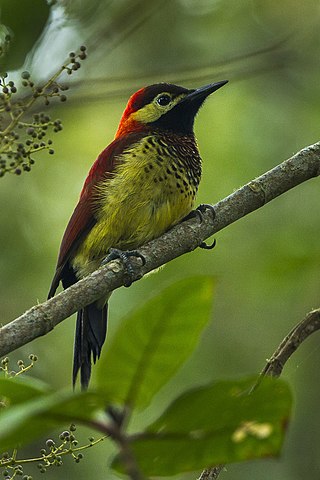
The white-necked jacobin is a medium-size hummingbird that ranges from Mexico south through Central America and northern South America into Brazil, Peru and Bolivia. It is also found in Trinidad & Tobago.

The barred antshrike is a passerine bird in subfamily Thamnophilinae of family Thamnophilidae, the "typical antbirds". It is found in the Neotropics in Mexico, every country in Central America, Trinidad and Tobago, and every mainland South American country except Chile and Uruguay. There is also one accepted record from southern Texas.

The olive-crowned flowerpecker is a small passerine bird in the flowerpecker family, Dicaeidae. It is found in far western New Guinea and on adjacent islands.

The yellow-browed antbird, or yellow-browed antwarbler, is a species of bird in subfamily Thamnophilinae of family Thamnophilidae, the "typical antbirds". It is found in Brazil, Colombia, Ecuador, and Peru.

The barred fruiteater is a species of bird in the family Cotingidae, found in Bolivia, Colombia, Ecuador, Peru, and Venezuela. Its natural habitat is subtropical or tropical moist montane forests. The population is stable, and they are considered common.

Pipreola is a genus of bird in the family Cotingidae. Together with Ampelioides tschudii, they are collectively known as fruiteaters. All are restricted to humid montane or foothill forest in western or northern South America. They are thickset birds with predominantly greenish upperparts. Males of most species have black heads and/or reddish, orange or yellow to the throat, chest or belly.

The golden-breasted fruiteater is a species of bird in the family Cotingidae. It is found in Colombia, and Venezuela, where its natural habitat is subtropical or tropical moist montane forests. Considering range and population size, this species is not considered vulnerable

The fiery-throated fruiteater is a species of bird in the family Cotingidae. It is found in Colombia, Ecuador, and Peru where its natural habitats are subtropical or tropical moist lowland forests and subtropical or tropical moist montane forests. It is becoming rare due to habitat destruction of its rainforest habitat.

The handsome fruiteater is a species of bird in the family Cotingidae. It is endemic to coastal mountains of northern Venezuela. Two populations of the species live in the northern mountainous regions, separated by 400 km (250 mi). Its natural habitat is subtropical or tropical moist montane forests.

The band-tailed fruiteater is a species of bird in the family Cotingidae. It is found at high altitudes in the subtropical and tropical moist montane forests of Bolivia and Peru. It is a plump green bird with chevron-shaped markings on the flanks and a tail with a black band and white tip. Males have a black head and bib and a narrow yellow collar, while females lack these features. Both sexes have red beaks and legs. This is a relatively common species with a wide range, and the International Union for Conservation of Nature has rated its conservation status as being "least concern".

The orange-breasted fruiteater is a species of bird in the family Cotingidae native to Colombia and Ecuador. Its natural habitat is subtropical or tropical moist montane forests. It is a plump green bird about 18 centimetres (7 in) long. Males have a glossy black head and bib, an orange throat and yellow belly. Females lack the dark head and have green upper parts and green and yellow streaked underparts. Both sexes have orange beaks and greyish-green legs. This is a relatively common species with a wide range, and the International Union for Conservation of Nature has rated its conservation status as being of "least concern".

The black-chested fruiteater is a species of bird in the family Cotingidae found in Colombia, Ecuador, and Peru, mostly on the eastern side of the Andes. Its natural habitat is subtropical and tropical moist montane forests and the IUCN lists its status as being of "least concern".

The masked fruiteater is a species of bird in the family Cotingidae endemic to Peru. Its natural habitat is subtropical or tropical moist montane forests on the eastern flanks of the Andes. Considering the bird's population size and its wide range, this species is classified by the IUCN as being of least concern.

The green-and-black fruiteater is a species of bird in the family Cotingidae. It is found in Colombia, Ecuador, Peru, and Venezuela, where its habitat is subtropical or tropical moist montane forests. Because of its range and population size this species is not classified as threatened.

The cinereous antshrike is an insectivorous bird in subfamily Thamnophilinae of family Thamnophilidae, the "typical antbirds". It is found in Bolivia, Brazil, Colombia, Ecuador, French Guiana, Guyana, Peru, Suriname, and Venezuela.

The plain softtail is a species of bird in the Furnariinae subfamily of the ovenbird family Furnariidae. It is found in Bolivia, Brazil, Ecuador, and Peru.

The yellow-throated woodpecker is a species of bird in subfamily Picinae of the woodpecker family Picidae. It is found in Bolivia, Brazil, Colombia, Ecuador, French Guiana, Guyana, Peru, Suriname and Venezuela.

The crimson-mantled woodpecker is a species of bird in subfamily Picinae of the woodpecker family Picidae. It is found in Bolivia, Colombia, Ecuador, Peru, and Venezuela.

The rufous-breasted piculet is a species of bird in subfamily Picumninae of the woodpecker family Picidae. It is found in Bolivia, Brazil, Colombia, Ecuador, and Peru.
P. frontalis may refer to:





















